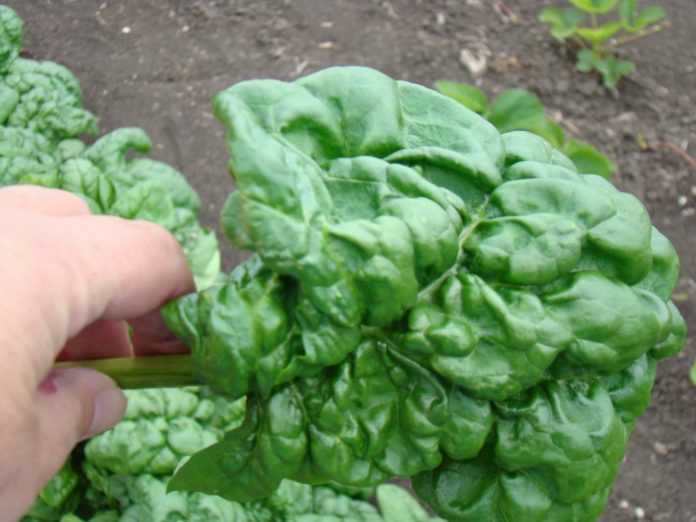Saskatchewan Perennial Society
Popeye the sailor man, invented by Elzie Crisler Segar, first appeared as a comic strip character in 1929. By 1932, Popeye was telling the world about spinach. Placed in a hopeless situation, a can of spinach would miraculously appear. Popeye would quickly consume its contents, gain superhuman strength and save the day. Thus, several generations of children were told by their parents to “eat their spinach.” Thankfully, frozen and fresh spinach are now available through our prairie winters and it is easily grown in our gardens. Spinach is an excellent source of vitamin C, high in calcium, magnesium, potassium, a good plant based source of iron and is one of the earliest vegetables to seed in the garden.
The genus name may have been derived from isfanakh, a Persian word for “green hand.” Spinacia is from the Medieval Latin, probably originating from the Latin word spina, referring to the spiny seeds. Oleracea means vegetable-like.
Our garden spinach (Spinacia oleracea) is believed to have developed from a wild form, Spinacia tetranda, still found in the Caucasus, Iran and Afghanistan. It was first cultivated by the Persians (in what is modern Iran) and 647AD had spread via Nepal to China. It was brought to Spain by the Moors. By 1351, it was common enough that “spinachium” had appeared on a list of food that monks were permitted to consume on fast days. In his Herbal of 1597, John Gerard in England described it as “watery and tasteless,” but wrote that it would be good for those with a hoarse voice or who had trouble breathing.
Spinach can be seeded early in spring, as soon as the ground is thawed: plants can withstand a few degrees of frost. Sow seeds 1.5-2 cm deep. For full sized spinach plants, space rows 30cm apart. For baby spinach leaves, rows can be closer together or scattered in a 30-60cm wide bed. With air temperatures above 10°C, seedlings should emerge in several days. Depending on the cultivar, baby spinach leaves will be ready for harvest in as little as 4 weeks after sowing.
Spinach can be grown as a ‘cut and come again’ crop ie. that means that spinach can be cut again and again and leaves will grow back from the same roots. When spinach is grown as a ‘cut and come again’ crop, it is usually harvested as baby spinach and can be grown as close as 3-4cm apart. To produce full sized spinach leaves, thin plants to 7-10cm between plants. Harvest spinach leaves by cutting petioles with a sharp knife just above the soil line.
Because spinach is such a fast grower, consider doing multiple plantings throughout the growing season for a consistent supply. Seed a short row every 2 weeks from early May to mid-August. Plants that are seeded between July 1st and August 15th may need to be harvested as baby spinach as spinach tends to bolt (flower) under high day temperatures. Bolting spinach as been a problem as long as spinach has been grown. In 1784, the D. Landreth Seed Company in United States had developed a slow-bolting spinach variety called ‘Bloomsdale’ which is still available today.
When purchasing spinach seed, gardeners may encounter three different types of spinach: savoy, semi-savoy or flat/smooth-leaf spinach. Although there is not much difference in the flavour or nutrient value of the different types; the leaf appearance is unique to each type. Savoy spinach has curly, crinkly leaves that are slightly thicker than other types. Semi-savoy spinach plants are slightly more upright and have less crinkly leaves than the savoy spinach types. As the name suggests, flat or smooth-leaf spinach has flat leaves. The flat leaves are the easiest type to wash: flat leafed spinach is the main type to be used in frozen spinach.
New Zealand spinach (Tetragonia tetragonioides) is a slightly vining leafy plant that produces copious amounts of greens during the summer: it is not a true spinach. New Zealand spinach requires warm temperatures and a longer time period for seeds to germinate as compared to Spinacea oleracea. New Zealand is sometimes referred to as perennial spinach however, it is not perennial on the Prairies.
Malabar spinach (Basella alba) is a perennial vining plant native to tropical areas of Africa and Asia. The leaves are oval to heart shaped, semi-succulent and mucilaginous when cooked. When eaten fresh, Malabar spinach is similar in flavour to Spinacia oleracea but with a slight peppery, citrus flavour. Malabar spinach is very frost sensitive and should be started indoors about 6 weeks prior to transplanting out for best results.
Recommended fresh spinach cultivars include: ‘Tyee’, ‘Space’, ‘Kolibri’ (baby type), ‘Escalade’, ‘Avon’
Retired from the University of Saskatchewan, Sara’s most recent book is Growing Fruit in Northern Gardens with Bob Bors. She’s been hosting garden tours for over 20 years – to Great Britain, Ireland, Europe, Turkey and Iceland. Join her for a tour of French gardens this September. Contact Ruth at 1-888-778-2378, or www.worldwideecotours.com. Jackie Bantle is horticulturist living on an acreage north of Saskatoon.
This column is provided courtesy of the Saskatchewan Perennial Society (SPS; saskperennial@hotmail.com ). Check our website (www.saskperennial.ca) or Facebook page (www.facebook.com/saskperennial) for a list of upcoming gardening events. The Spring Plant Exchange will be held on Sunday, May 29. The plant exchange will start around two o’clock for more information please see the website. These are “member only” events, but memberships are available at the door for $10.00.


